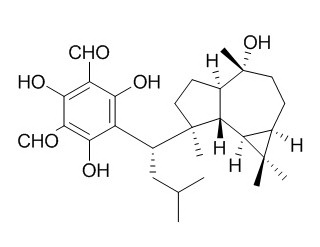Macrocarpal B
The intestinal absorption of M-A, Macrocarpal B, and Cy-C was passive diffusion as the dominating process and Cy-C was partly ATP-dependent.
Inquire / Order:
manager@chemfaces.com
Technical Inquiries:
service@chemfaces.com
Tel:
+86-27-84237783
Fax:
+86-27-84254680
Address:
1 Building, No. 83, CheCheng Rd., Wuhan Economic and Technological Development Zone, Wuhan, Hubei 430056, PRC
Providing storage is as stated on the product vial and the vial is kept tightly sealed, the product can be stored for up to
24 months(2-8C).
Wherever possible, you should prepare and use solutions on the same day. However, if you need to make up stock solutions in advance, we recommend that you store the solution as aliquots in tightly sealed vials at -20C. Generally, these will be useable for up to two weeks. Before use, and prior to opening the vial we recommend that you allow your product to equilibrate to room temperature for at least 1 hour.
Need more advice on solubility, usage and handling? Please email to: service@chemfaces.com
The packaging of the product may have turned upside down during transportation, resulting in the natural compounds adhering to the neck or cap of the vial. take the vial out of its packaging and gently shake to let the compounds fall to the bottom of the vial. for liquid products, centrifuge at 200-500 RPM to gather the liquid at the bottom of the vial. try to avoid loss or contamination during handling.
Malaysian Journal of Analytical Sciences2022, 26(2):360-369.
Chengdu University of Traditional Chinese Medicine2024, 4802935.
PLoS One.2018, 13(11):e0208055
Phytomedicine Plus2024, 4(4): 100655.
Mol Pharmacol.2021, 99(2):163-174.
Foods.2022, 11(6):882.
J Nat Prod.2022, 85(5):1351-1362.
Chem Biol Interact.2018, 283:59-74
Biofactors.2018, 44(2):168-179
Phytomedicine2022, 104:154337.
Related and Featured Products
Bioorg Med Chem Lett. 2007 Feb 15;17(4):1107-11.
Intestinal permeability of antivirus constituents from the fruits of Eucalyptus globulus Labill. in Caco-2 Cell Model.[Pubmed:
17118653]
The uptake and transepithelial transport of the three main constituents macrocarpal A (M-A), Macrocarpal B (M-B), and cypellocarpa C (Cy-C) from the fruits of Eucalyptus globulus Labill. were investigated.
METHODS AND RESULTS:
Monolayers of the human intestinal epithelial cancer cell line Caco-2 were incubated with M-A, Macrocarpal B, and Cy-C to model its intestinal absorption and transport, respectively. The determination of compounds was performed by HPLC. The apparent permeability coefficients (P(app)) for M-A, Macrocarpal B, and Cy-C in the apical-to-basolateral direction of a Caco-2 monolayer were (1.70+/-0.06)x10(-6), (1.99+/-0.10)x10(-6), and (6.08+/-0.41)x10(-6)cm/s, respectively. In the presence of iodoacetamide, the P(app) of Cy-C were both reducted in apical-to-basolateral and basolateral-to-apical directions. M-A and Macrocarpal B appear to accumulate in the epithelial cells.
CONCLUSIONS:
The intestinal absorption of M-A, Macrocarpal B, and Cy-C was passive diffusion as the dominating process and Cy-C was partly ATP-dependent.
Zhongguo Zhong Yao Za Zhi. 2007 Mar;32(6):496-500.
[Studies on chemical constituents in fruits of Eucalyptus globulus].[Pubmed:
17552153]
To study the chemical constituents in the fruits of Eucalyptus globulus Labill.
METHODS AND RESULTS:
The chemical constituents were isolated by various column chromatographic methods and structurally elucidated by IR, NMR and MS evidences. Fifteen compounds were obtained and identified as beta-sitosterol (1), betulinic acid (2), stigmasterol (3), euscaphic acid (4), 2a-Hydroxybetulinic acid (5), Macrocarpal B (6), macrocarpal A (7), oleanolic acid (8), 3,4,3'-O-trimethylellagic acid (9), 3-O-methylellagic acid 4'-O-(2"-O-acetyl )-alpha-L-rhamnopyranoside (10), camaldulenside (cypellocarpin C, 11), 3-O-methylellagic acid 4'-O-alpha-L-rhamnopyranoside (12), 3-O-methylellagic acid (13), ellagic acid (14), and gallic acid (15).
CONCLUSIONS:
Compounds 4 and 5 from genera Eucalyptus, 1, 3 and 11 from plant E. globulus, and 6, 7, 9 and 15 from the fruits of E. globulus were isolated for the first time.
Biosci. Biotech. Biochem., 1995, 59(12):2330-2.
New Macrocarpal-am-1 from Eucalyptus amplifolia.[Reference:
WebLink]
METHODS AND RESULTS:
Four macrocarpals (macrocarpal A, Macrocarpal B, Macrocarpal E, and macrocarpal am-1) were isolated from the leaves of Eucalyptus amplifolia.
CONCLUSIONS:
Macrocarpal-am-1 is a new macrocarpal in which the isopentyl phloroglucinol chromophore is coupled with the 1,10-secoaromadendrane skeleton. Its structure is elucidated by spectral techniques.



